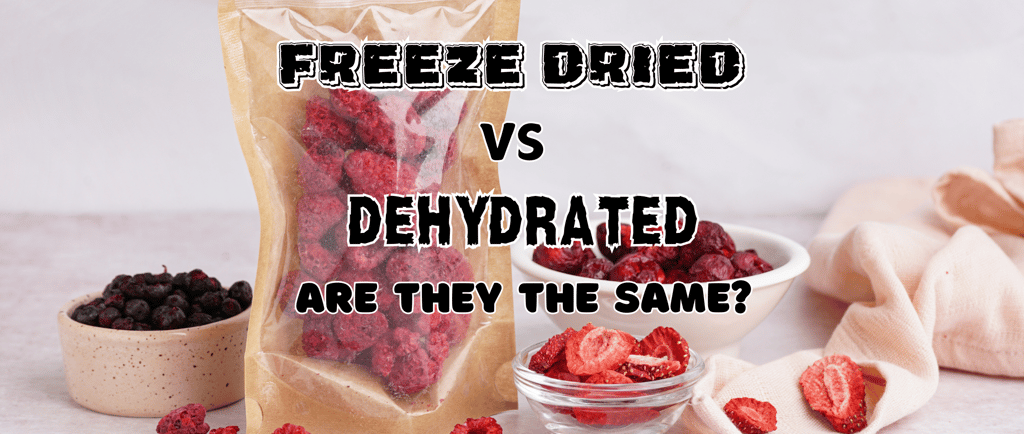Is Freeze-Dried and Dehydrated the Same Thing? Discover the Key Differences and Benefits of Each
Is freeze drying and dehydrating the same thing? Discover the science, nutrition, and benefits of each method, and find out which is right for your needs.
HOMESTEADING


When it comes to preserving food, one question often surfaces: Is freeze-dried and dehydrated the same thing? On the surface, freeze drying and dehydrating might look similar—they both remove moisture from food to extend shelf life—but the differences between these methods are vast and significant. If you’ve ever wondered which preservation technique is better for nutrients, texture, or long-term storage, you’re not alone. Let’s explore the distinctions and decide which method might be best for your needs.
Why Food Preservation Matters
In today’s fast-paced world, where we’re always looking to save time and money, preserving food efficiently is a valuable skill. Fresh food can spoil quickly, wasting money and nutrients, while preserved food can last for months, if not years, giving you control over your pantry and diet. But not all preservation methods are created equal. This is especially true with freeze drying and dehydrating, two methods with unique benefits and drawbacks that can make one more suitable than the other, depending on your lifestyle and goals.
What’s the Difference Between Dehydrating and Freeze Drying?
Understanding the difference between a dehydrator and a freeze dryer is essential to picking the right preservation method. While both processes aim to remove moisture, they do so in vastly different ways. Let’s dive deeper into how each works, why it matters, and what you should consider when choosing between the two.
How Dehydrating Works
Dehydrating is one of the oldest forms of food preservation. It involves applying low heat to food, usually around 125°F to 160°F (52°C to 71°C), to evaporate moisture. This process takes anywhere from a few hours to over a day, depending on the food and the temperature. Most dehydrated foods retain about 5-10% of their original moisture, which is enough to prevent spoilage but still affects the texture and taste.
Pros of Dehydrating: It’s relatively affordable and accessible, as all you need is a dehydrator or even an oven. Dehydration is ideal for people looking to preserve food for camping or short-term storage, as it produces lightweight, compact food.
Cons of Dehydrating: Heat can degrade certain nutrients, like vitamin C and some B vitamins. Additionally, dehydrated foods often have a chewier texture, which may not appeal to everyone.
How Freeze Drying Works
Freeze drying is a more modern technique. Instead of using heat, it works by freezing the food at extremely low temperatures, then creating a vacuum around it. This vacuum removes the frozen water content directly, turning ice into vapor without passing through a liquid stage (a process called sublimation). The result? Foods retain a significantly higher portion of their nutrients and structure, leaving them light, airy, and nearly indistinguishable from their fresh counterparts once rehydrated.
Pros of Freeze Drying: This process preserves nutrients exceptionally well, making it ideal for long-term storage with minimal nutrient loss. Freeze-dried foods also have a long shelf life, often lasting up to 25 years when stored correctly.
Cons of Freeze Drying: Freeze dryers are costly, bulky, and require more energy to operate. Freeze drying at home is an investment, both financially and in terms of space.
Nutritional Differences: Which Preservation Method is Healthier?
A major advantage of freeze drying is that it retains up to 97% of a food’s nutritional content, compared to dehydrating, which may retain about 60-80%. Since freeze drying uses a cold process, it preserves heat-sensitive nutrients better, making it a preferred choice if you’re concerned about maximum nutrient retention. However, both methods still provide a healthy alternative to canned or commercially processed foods laden with preservatives and added sugars.
Textural and Taste Differences
Dehydrated foods have a chewy or leathery texture, while freeze-dried foods are crisp and light. This difference is due to the amount of moisture each method leaves behind. If you’re looking for a snack you can eat right out of the bag, freeze-dried foods offer a satisfying crunch that most people enjoy. However, if you plan to rehydrate your food for cooking, dehydrated foods might provide a closer resemblance to the original texture when used in recipes.
Storage, Shelf Life, and Convenience
If long-term storage is your goal, freeze drying is the winner. Freeze-dried foods, when stored in airtight, moisture-free containers, can last up to 25 years. Dehydrated foods, on the other hand, generally last between 1 to 5 years, depending on storage conditions. For survivalists, homesteaders, or those preparing for emergencies, freeze-dried foods offer a stable option with minimal risk of spoilage.
Cost and Equipment: Freeze Dryer vs. Dehydrator
Dehydrators are typically smaller, more affordable, and easy to find in kitchen appliance stores, making them a practical choice for most home cooks. Freeze dryers, however, are significantly more expensive and larger, making them less accessible for the average household. If you’re interested in freeze drying but are concerned about cost, purchasing freeze-dried foods commercially might be a better option.
Energy Efficiency
Dehydrators use lower temperatures and shorter processing times, consuming less energy than freeze dryers. Freeze drying, while effective, requires more energy due to the extreme cold and vacuum creation, which may increase electricity costs for those using it regularly.
Environmental Impact of Each Method
From an environmental standpoint, dehydrators generally have a lower footprint due to their reduced energy consumption. However, freeze-dried foods tend to have less spoilage over time, which may reduce food waste overall. Choosing between the two may also depend on your personal values: if minimizing food waste is your top priority, freeze drying might have an edge.
Frequently Asked Questions: Clearing Up Common Misconceptions
Is freeze-dried the same as dehydrated?
No, while both processes remove moisture, freeze drying retains more nutrients and flavor, resulting in a crisp, airy texture, whereas dehydrated foods are chewier.Does freeze drying destroy nutrients?
Minimal nutrient loss occurs in freeze drying, making it one of the best preservation methods for nutrient retention.Can I dehydrate food without a dehydrator?
Yes, you can use an oven on low heat, although results may vary based on the food type and temperature consistency.Is freeze drying more expensive than dehydrating?
Yes, the equipment and process of freeze drying are generally more costly, but for those committed to long-term food preservation, the investment might be worthwhile.
So, Which Is Better: Dehydrating or Freeze Drying?
Ultimately, choosing between dehydrating and freeze drying depends on your personal needs, budget, and storage space. Dehydrating is accessible, affordable, and effective for shorter-term storage. Freeze drying, while costly, is unbeatable for nutrient preservation, shelf life, and versatility in storage. Whether you’re building an emergency pantry, preparing for outdoor adventures, or simply enjoying your favorite fruits and vegetables year-round, knowing the differences between these methods will help you make the best choice for your lifestyle.
Making the Choice That Fits Your Needs
Now that you know the differences between freeze drying and dehydrating, you’re equipped to make a choice that aligns with your goals, whether it’s health, cost, or convenience. Each method has unique advantages, and whichever you choose, you’ll have a reliable way to preserve food and enjoy a taste of freshness anytime.
Ready to Start Preserving?
If you’re ready to take control of your food preservation, consider experimenting with both methods to see what works best for you. A dehydrator might be a great first step, but if you’re looking for something more advanced, freeze drying could be the next big step in your preservation journey.
Ready to Skip the Hassle and Get Long-Lasting, Nutritious Food Now?
If you want to skip the hassle and costs associated with freeze drying or dehydrating at home, we’ve found the ultimate solution for you! With the READYWISE Variety Pack Bucket, you’ll have an incredible 104 servings of freeze-dried, ready-to-eat meals that last up to 25 years. Whether you're preparing for emergencies, planning a hiking adventure, or simply want a quick, nutritious option on hand, this kit has you covered with premium, individually packaged meals—no complicated equipment or storage needed.
Don’t wait until it’s too late to have peace of mind. Click here to secure your READYWISE freeze-dried meal pack now and experience the ease and convenience of truly prepared living.
Support@rusticrootshomestead.com
© 2024 Rustic Roots Homestead - All rights reserved.
